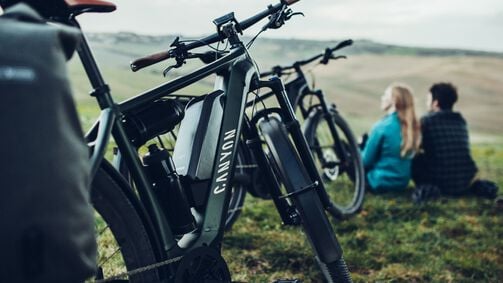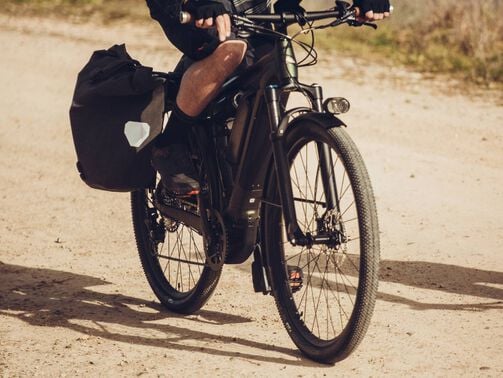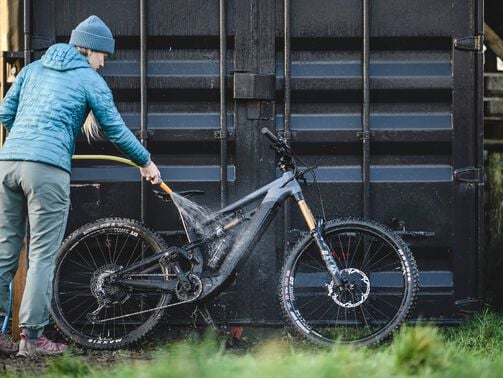Electric bike range: Everything you need to know
More range means more kilometres and more fun in the saddle. Read on to find out everything you need to know about e-bike range.


E-bikes allow all different kinds of cyclists to achieve an amazing variety of things on two wheels. Whether you’re riding to recover lost fitness after a lengthy injury or illness, or you’re trying to keep up with friends who have more time to train than you do – e-bikes act as a great leveller, as well as giving more people access to the joys of cycling. When it comes to choosing an e-bike to purchase, one of the biggest factors in the decision is range - but what is range, and how does it change with the use of the bike?
Contents
What is e-bike range and how is it measured?
To put it simply, an electric bicycle’s range is the distance it can travel on a full battery before needing to be plugged in and recharged. The range of an e-bike is typically supplied as a distance in kilometres and sometimes may also be referred to using the term ‘autonomy’. A long-range electric bike ought to be able to manage over 140km on a single charge, however there are other types of cycling where e-bike range is not the utmost concern. For example, in some MTB disciplines, the bike’s electric assistance will be used to get back up the hill before another unassisted downhill run, meaning it needs good power output to winch you up the incline, but not the capacity to keep plugging away for over 150km.

Factors that impact electric bike range
It’s important to know your e-bike’s range, but you should always assume that this number is the upper limit of how far the bike can go before needing some more juice. Why? Because there are a whole heap of factors that may prevent your e-bike reaching that absolute maximum number.
- Battery capacity in watt-hours (Wh)
- Total combined weight of rider & e-bike
- Route geography (hilly vs. flat)
- Level of assistance
- Gear selection
- Your riding style/constant stop-and-start riding
- External temperature
- Headwind/tailwind
- Charging behaviour
- Tyre choice and pressure
- Cadence (whether you ‘spin’ your legs fast or ‘grind’ them slowly)
We’re mainly going to be talking about e-bike range in the context of a brand-new model, but it’s worth remembering that e-bike range will also decline over time as your battery ages. A brand new Spectral:ON purchased direct from canyon.com today will have a greater range as a new bike than it will after four or five years of happy shredding. Of course, it’s always possible to replace an ageing battery or even to upgrade it beyond the capacity of the one you originally bought.

What range do Canyon e-bikes have?
It primarily depends on the model, the motor, and the battery. Furthermore, the ranges stated on the Canyon website can be influenced by lots of different variables. Still, you can rely on these figures for an approximate guide of the real-world range.
Up to 100 km range
With e-mountain bikes you can easily explore nature and your local area. Power over off-road tracks, forest gravel paths, and through winding trails – all with up to 100 kilometres of range with a Canyon e-MTB. Depending on your riding style and terrain, pick from the Neuron:ONfly, Spectral:ONfly, Torque:ON, and more besides.
Up to 120 km range
If you’re looking to ride up to 120 km between charges, then Canyon models like the Grizl:ONfly and Roadlite:ONfly are just the ticket. The Grizl:ONfly is an e-gravel bike for adventurous off-road fun on gravel paths and forest dirt roads, whereas the Roadlite:ONfly is an efficient, fast e-hybrid for everyday riding.
Up to 150 km range
In it for the long haul? Then you should explore our Canyon Pathlite:ONfly range, for instance. These advanced e-touring bikes are packed full of features to enhance a multi-day bike trip, and also have the furthest range.
Maximising your e-bike range: Tips and strategies for longer rides
To get the best out of your e-bike, there are a few simple things you can do. This advice combines long-term habits you can adopt to really sustain your e-bike’s performance and shorter-term things to bear in mind on each individual ride.
Optimising your e-bike’s battery life
There are a few ways to optimise the lifespan of your e-bike battery, both in terms of how quickly it drains while riding, and the rate at which its performance degrades over time.
Use the right e-support mode
One of the easiest things you can do to increase the range of your e-bike is to use the right motor assistance level for your riding situation. If you only ever use the strongest setting, your battery will drain faster than on the lowest setting. Picking the right motor mode will really boost your e-bike range.
Charge your e-bike battery the right way
To extend the life of your battery over many rides and charges, you need to charge your battery properly. Avoid charging it fully up to 100% power and then riding until the battery is completely empty. More than anything, draining the battery right down can cause damage over the long term. As a general guide, the optimum charging range is usually specified between 20%-80%.
Riding habits for longer e-bike range
Of course, it’s not just how you look after your battery that impacts the range, it’s also how you ride your bike.
Plan a flatter route
The shortest route from A to B is not always the most efficient. To extend your battery life, consider planning a flatter course with less elevation. This can significantly increase the range of your e-bike.
Choose suitable tyres and tyre pressure
Picking the correct tyres and pumping them up to the correct pressure can also make a considerable impact on the range of your e-bike. In mountain biking, riders often use low pressures and knobbly tyres to generate maximum grip. However, this also increases rolling resistance, which sucks more battery power. In road and gravel cycling, riders generally use higher pressures and this has less of an impact on the range of the bike.
Ride in the right gear
Shifting into a suitable gear is also important for the range of your e-bike. You just need to use a gear that you can pedal comfortably. You shouldn’t have to spin your legs super-fast like a washing machine, or be ‘grinding’ too slowly and have to push down too forcefully on the pedals to keep them turning.
Drop the ‘stop-start’ style
Abrupt stopping and starting time after time requires more energy than pedalling at a consistent speed. Try to ride smooth and steady, so you’re starting from a standstill as little as often. Brake steadily in advance of a traffic light or junction, rather than screaming toward it then stopping in a second. This will maintain your bike’s battery capacity, increasing the range of your bike.

Additional tips and tricks
Here are some other ways you might be able to extend your e-bike range.
Reduce overall weight
If you reduce the overall weight of rider and bike, the motor has to generate less power to support you. So before you hit the road, double-check you’re only carrying gear that you really need – or if you can use a lighter overall setup. This might include using a light, all-in-one multi-tool, dropping that second water bottle, or leaving that heavy winter jacket at home in favour of a lighter alternative. Another option is to reduce the weight of the bike itself. Fitting carbon components, titanium screws, and thinner single-ply tyres are just some of the possibilities available.
Keep your e-bike clean
We don’t want to sound like your tired parent asking you to tidy your room, but it’s true that if you look after your e-bike, it will look after you! Keeping your e-bike clean is a great way to extend the life of its componentry, including the battery.
In extreme weather, pack your charger
The weather has a big effect on your e-bike’s range. In cold temperatures, batteries drain faster, and when you’re pedalling into a headwind, your motor has to push harder which reduces range. When the weather’s bad, bring your charger along so you can recharge your bike in a pinch
Do electric bikes recharge when you pedal?
While there are some e-bikes on the market that recharge themselves, it’s fair to say that right now the amount of energy generated does not make a meaningful contribution to the overall autonomy of the bike.
It’s a common misconception that self-charging e-bikes take energy from the rider’s pedal strokes. In fact, riding a bike that used your pedal power to charge up the battery would feel like riding with the brakes firmly on all the time – the extra resistance applied to each pedal stroke would soon sap your strength and it wouldn’t be very enjoyable to ride.
Those e-bikes that do have a self-charging component tend to do so through regenerative braking. This is where the kinetic energy that is created when the brakes are engaged is turned into stored electrical energy. It’s a very common tech in hybrid cars, but the weight of most bicycles means that the forces involved in stopping them simply aren’t large enough to really recharge your e-bike battery.
There are also some bikes that use solar panels on the bike to generate electric energy that is then stored in the battery and used to propel the motor. However, these systems are still some way short of harvesting the kind of energy needed to keep you rolling over multiple kilometres.
The days of a long range electric bike with total independence from the power grid are still some ways off, sadly.
Choosing the right Canyon e-bike for longer rides
For out and out range, you can’t do much better than the Pathlite:ON 8 SUV. It boasts up to 150km of autonomy between charges – enough for you to enjoy two or three back to back touring days before having to juice up again.
When it comes to your longest rides, our biggest tip is to use a range extender. That’s a backup battery that you use to add more juice, thus elevating your e-bike’s range. There is naturally a weight penalty that comes with taking a range extender, but it’s not so much heavier that it’ll drastically impact your entire bike + rider overall weight.
Our Grizl:ONfly is a great example of a bike that uses a range extender. The bike comes with a 400Wh Bosch battery as standard, but we also carry the Bosch PowerMore 250Wh range extender – giving you an extra 62% range. On the Grizl:ONfly that translates to a combined range of roughly 150km.
Now you know about e-bike range, check out our e-bike buyer’s guide so you can make an informed decision about which Canyon e-bike is going to best suit your needs.
Did this article help?
Thank you for your feedback




